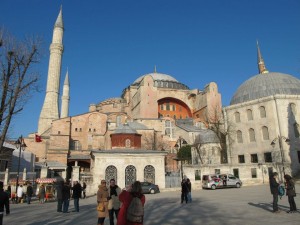40 things to do before you’re 40 – Number 31
Tuesday, October 8th, 2013
Stroll across continents and through the centuries in Istanbul

Sunset on the Bosphorus
If the Earth were a single state, Istanbul would be its capital – Napoleon Bonaparte
Picture the scene: an evening sun sets silhouetting an undulating row of domes and minarets in the distance; in front of you an entire armada of every known type of vessel, from humble fishing boat to mighty oil tanker, criss-crosses the Boshphorus that separates you from Asia; as you sip on your tea the light breeze off the straight carries with it the compelling sound of a hundred competing calls to prayer and the rich smell of a multitude of spices and dishes being cooked up all around you. Welcome to Istanbul!
Straddling two continents, this magnificent city is a bustling and lively metropolis set amidst the timeless remnants of centuries of history and competing civilisations, making it one of the most exciting destinations on any traveller’s roadmap.
A brief history through time
The first to occupy this coveted spot was the Greek city of Byzantium over 500 years before Christ. In the fourth century BC, some 200 years after the city was absorbed by the Roman Empire, then Emperor Constantine decided to relocate the capital of the entire Empire from Rome to what would become known as Constantinople. After the Roman Empire split, the Eastern Empire, better known as the Byzantine Empire, continued to thrive for centuries after the downfall of its western counterpart with Constantinople as its capital. By the 15th century AD the burgeoning Ottoman Empire had conquered all of the Byzantine Empire beyond Constantinople. This once mighty empire, now reduced to just the city within its fortified walls – the remnants of which are still very much visible today – survived an eight-week-long siege before finally falling under Ottoman rule. It wasn’t until after the Ottoman Empire itself collapsed 500 years later and the modern state of Turkey was created that the city would come to be known as Istanbul.
Present-day Istanbul
Often touted today as the place where ‘East meets West’, this tag is as much a cultural description as it is a geographic location, as centuries of influence from both camps compete to create its modern landscape. And there is no better way to absorb the cultural contrast and lengthy history than to stroll through the centuries as you saunter down the city’s streets and narrow alleys, encountering ancient relics and religious monuments, all the while being greeted by the exotic sights, sounds and smells of modern Turkish culture.
Five must-dos in Istanbul
– See the city’s grandeur from the water on a Bosphorus cruise: whether you choose a two-hour option or go for a full afternoon on the water, this is a truly fabulous experience not to be missed as it gives you the most comprehensive perspective of the city from the very waters that define its existence.
– ‘Come into my shop while I rip you off!’ You will inevitably be hassled as you stroll the maze of aisles and hundreds of shops that make up the Grand Bazaar, but don’t let this put you off; instead take it in your stride, as it’s frequently good natured and often even entertaining. Even if you’re not looking to buy, just witnessing the variety of what’s on offer and the techniques used to lure you in is worth experiencing at least once.
– Stand in the middle of the Hagia Sophia and gaze up in awe at the dome above you. Commissioned to be a cathedral worthy of a mighty empire, the Hagia Sofia was and still is an architectural masterpiece. It also embodies the history of the city, as evidence of its conversion from cathedral to mosque and then museum is very much evident.
– While the Sultan Ahmed Mosque, better known as the Blue Mosque, is the most famous and renowned throughout the Muslim world for its architectural splendour and definitely worth a visit, the older, and in fact bigger, Suleymaniye Mosque with its combination of Islamic and Byzantine styles shouldn’t be missed either.
– One evening choose from the many nargile bars to be found under the Galata Bridge spanning the Golden Horn and lie back on a beanbag and witness a spectacular sunset while puffing on a water pipe sampling a variety of flavoured tobacco or just sipping on a rich Turkish coffee or refreshing beer.
Nearly all of Topdeck’s trips in Turkey include a few magical days in Istanbul, which will give you the chance to really get a grip on this culturally fascinating and historic city.








